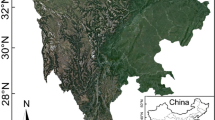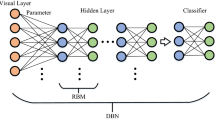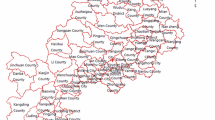Abstract
Landslides dataset of Sichuan Province in China, containing 1551 historical individual landslides, is a result of two teams’ effort in the past few years, based on which landslide susceptibility can be mapped. Considering complex internal relations among the triggering factors, logistic regression (LR) and shallow neural networks, such as back propagation neural network (BPNN), are often limited. In this paper, we make a straightforward development that the deep belief network (DBN) based on deep learning technology is introduced to map the regional landslide susceptibility. Seven key factors with respect to geomorphology, geology, and hydrology are considered, and a DBN model containing three pre-trained layers of Restricted Boltzmann Machines (RBM) by stochastic gradient descent (SGD) method is configured to obtain the landslide susceptibility. In the receive operator characteristic (ROC) analysis, comparing DBN with LR and BPNN shows that DBN has a better prediction precision, with lower false alarm rate and fake alarm rate. This research will contribute to a better-performance model for regional-scale landslide susceptibility mapping, in particular at the area where triggering factors show complex relation and relative independence.
Access this chapter
Tax calculation will be finalised at checkout
Purchases are for personal use only
Similar content being viewed by others
References
Abedini M, Tulabi S (2018) Assessing LNRF, FR, and AHP models in landslide susceptibility mapping index: a comparative study of Nojian watershed in Lorestan province. Iran Environ Earth Sci 77(11):405
Aditian A, Kubota T, Shinohara Y (2018) Comparison of gis-based landslide susceptibility models using frequency ratio, logistic regression, and artificial neural network in a tertiary region of Ambon, Indonesia. Geomorphology 318:101–111
Alexander DE (2004) Vulnerability to landslides. In: Glade T et al (eds) Landslide Hazard and Risk. Wiley, Hoboken, pp 175–198
Arian R, Peter M (1998) Receiver operating characteristic (ROC) analysis: Basic principles and applications in radiology. Eur J Radiol 27(2):88–94
Arora MK, Das Gupta AS, Gupta RP (2004) An artificial neural network approach for landslide hazard zonation in the Bhagirathi (Ganga) Valley, Himalayas. Int J Rem Sens 25(3):559–572
Avtar R, Singh CK, Singh G, Verma RL, Mukherjee M, Sawada H (2011) Landslide susceptibility zonation study using remote sensing and GIS technology in the Ken-Betwa River Link area, India. Bull Eng Geol Env 70(4):595–606
Ballabio C, Sterlacchini S (2012) Support vector machines for landslide susceptibility mapping: the Staffora river basin case study, Italy. Mathem Geosci 44(1):47–70
Brabb EE (1984) Innovative approaches to landslide hazard mapping. In: Proceedings of the 4th international symposium on landslides, Toronto 1, pp 307–324
Carrara A, Cardinali M, Detti R, Guzzetti F, Pasqui V, Reichenbach P (1991) GIS techniques and statistical models in evaluating landslide hazard. Earth Surf Proc Land 16:427–445
Chen W, Xie XS, Wang JL et al (2017) A comparative study of logistic model tree, random forest, and classification and regression tree models for spatial prediction of landslide susceptibility. CATENA 151:147–160
Cheng DQ, Cui YF, Su FH, Jia Y, Choi CE (2018) The characteristics of the Mocoa compound disaster event, Colombia. Landslides 15:1223–1232
Cogan J, Gratchev I, Wang GH (2018) Rainfall-induced shallow landslides caused by ex-Tropical Cyclone Debbie, 31st March 2017. Landslides 15(6):1215–1221
Dalal N, Triggs B, Schmid C (2006) Human detection using oriented histograms of flow and appearance. Springer, Berlin Heidelberg, pp 428–441
Demir G, Aytekin M, Akgün A, Ikizler SB, Tatar O (2013) A comparison of landslide susceptibility mapping of the eastern part of the North Anatolian Fault Zone (Turkey) by likelihood-frequency ratio and analytic hierarchy process methods. Nat Hazards 65:1481–1506
Ghahabi O, Hernando J (2014) Deep belief networks for i-vector based speaker recognition. In: Proceedings of 2014 international conference on acoustics, speech and signal processing. Florence: IEEE 2014, pp 1700–1704
Han Z, Chen GQ, Li YG et al (2015a) Numerical simulation of debris-flow behavior incorporating a dynamic method for estimating the entrainment. Eng Geol 190:52–64
Han Z, Li YG, Du YF, Wang WD, Chen GQ (2018a) Noncontact detection of earthquake-induced landslides by an enhanced image binarization method incorporating with Monte-Carlo simulation. Geomat Nat Hazards Risks 10(1):219–241
Han Z, Wang WD, Li YG, Huang JL, Chen GQ et al (2018b) An integrated method for rapid estimation of the valley incision by debris flows. Eng Geol 232:34–45
Han Z, Chen GQ, Li YG et al (2015b) Exploring the velocity distribution of debris flows: an iteration algorithm based approach for complex cross-sections. Geomorphology 241:72–82
Han Z, Chen GQ, Li YG et al (2015c) Assessing entrainment of bed material in a debris-flow event: a theoretical approach incorporating Monte Carlo method. Earth Surf Proc Land 41:1877–1890
Hosseinzadeh M, Servati M, Mansouri A, Mirbagheri B, Khezri S (2009) Landslide hazard zonation using logistic regression, the way Sanandaj-Dehgolan, Iran. J Geol 11:27–37
Kanungo DP, Sarkar S, Sharma S (2011) Combining neural network with fuzzy, certainty factor and likelihood ratio concepts for spatial prediction of landslides. Nat Hazards 59(3):1491
Kwiatkowski F, Gachon F, Charrier S et al (1999) Decision-making strategy in biology—ROC analysis. Bull Cancer 86(9):787–789
Listo FDLR, Carvalho VB (2012) Mapping of risk and susceptibility of shallow-landslide in the city of Sao Paulo, Brazil. Geomorphology 169–170:30–44
Liu G, He J, Li R et al (2018) Topological and dynamic complexity of rock masses based on GIS and complex networks. Physica A 512:1240–1248
Liu XW, Chen Q, Zhao JJ et al (2020) The spatial response pattern of coseismic landslides induced by the 2008 Wenchuan earthquake to the surface deformation and Coulomb stress change revealed from InSAR observations. Int J Appl Earth Observ Geoinf 87
Lydia EE, Daniel B (2002) Land slide hazard and risk zonation mapping in the Rio Grande basin, central Andes of Mendoza, Argentina. Mt Res Dev 22(2):177–185
Mao Y, Zhang M, Sun P, Wang G (2017) Landslide susceptibility assessment using uncertain decision tree model in loess areas. Environ Earth Sci 76(22):752
Meten M, Bhandary NP, Yatabe R (2015) GIS-based frequency ratio and logistic regression modelling for landslide susceptibility mapping of Debre Sina area in central Ethiopia. J Mt Sci 12(6):1355–1372
Ministry of Land and Resources (2016) National geological disaster bulletin. Technical Guidance Center for Geological Disaster Emergency Response of Ministry of Land and Resources
Nguyen HT, Nguyen LT (2019) ROC curve analysis for classification of road defects. Brain: Broad Res Artif Intell Neurosci 10(2):65–73
Palamakumbure D, Flentje P, Stirling D (2015) Consideration of optimal pixel resolution in deriving landslide susceptibility zoning within the Sydney Basin, New South Wales, Australia. Comput Geosci 82:13–22
Park I, Lee S (2014) Spatial prediction of landslide susceptibility using a decision tree approach: a case study of the Pyeongchang area, Korea. Int J Remote Sens. 35(16):6089–6112
Park SH, Goo JM, Jo CH (2004) Receiver operating characteristic (ROC) curve: practical review for radiologists. Korean J Radiol 5(1):11–18
Polykretis C, Chalkias C (2018) Comparison and evaluation of landslide susceptibility maps obtained from weight of evidence, logistic regression, and artificial neural network models. Nat Hazards 93(3):1–26
Polykretis C, Ferentinou M, Chalkias C (2015) A comparative study of landslide susceptibility mapping using landslide susceptibility index and artificial neural networks in the Krios River and Krathis River catchments (northern Peloponnesus, Greece). Bull Eng Geol Env 74(1):27–45
Pradhan B, Sezer EA, Gokceoglu C, Buchroithner MF (2010) Landslide susceptibility mapping by neuro-fuzzy approach in a landslide prone area (Cameron Highland, Malasia). IEEE Trans Geosci Remote Sens 48(12):4164–4177
Raja NB, Cicek I, Turkoglu N, Aydin O (2017) Landslide susceptibility mapping of the Sera River Basin using logistic regression model. Nat Hazards 85(3):1323–1346
Ramesh V, Anbazhagan S (2015) Landslide susceptibility mapping along Kolli hills Ghat road section(India) using frequency ratio, relative effect and fuzzy logic models. Environ Earth Sci 73:8009–8021
Reichenbach P, Rossi M, Malamud BD et al (2018) A review of statistically-based landslide susceptibility models. Earth Sci Rev 180:60–91
Rioux L, Giguere P (2014) Sign language fingerspelling classification from depth and color images using a deep belief network. In: Proceedings of 2014 Canadian conference on computer and robot vision. Quebec: IEEE 2014, pp 92–97
Sahana M, Sajjad H (2017) Evaluating effectiveness of frequency ratio, fuzzy logic and logistic regression models in assessing landslide susceptibility: a case from Rudraprayag district, India. J Mount Sci 14(11):2150–2172
San BT (2014) An evaluation of SVM using polygon-based random sampling Inlandslide susceptibility mapping: the Candir catchment area (western Antalya, Turkey). Int J Appl Earth Obs Geoinf 26:399–412
Sdao F, Lioi DS, Pascale S, Caniani D, Mancini M (2013) Landslide susceptibility assessment by using a neuro-fuzzy model: a case study in the Rupestrian heritage rich area of Matera. Nat Hazards Earth Syst Sci 13:395–407
Sezer EA, Pradhan B, Gokceoglu C (2011) Manifestation of an adaptive neuro-fuzzy model on landslide susceptibility mapping: Klang valley, Malaysia. Expert Syst Appl 38(7):8208–8219
Shao JA, Li YB, Ni JP (2012) The characteristics of temperature variability with terrain, latitude and longitude in Sichuan-Chongqing region. J Geog Sci 22(2):223–244
Shirzadi A, Bui DT, Pham BT et al (2017) Shallow landslide susceptibility assessment using a novel hybrid intelligence approach. Environ Earth Sci 76(2):60
Su C, Wang L, Wang X, Huang Z, Zhang X (2015) Mapping of rainfall-induced landslide susceptibility in Wencheng, China, using support vector machine. Nat Hazards 76:1759–1779
Wang WD, Guo J, Fang LG, Chang XS (2012) A subjective and objective integrated weighting method for landslides susceptibility mapping based on GIS. Environ Earth Sci 65(6):1705–1714
Wang WD, Xie CM, Du XG (2009) Landslides susceptibility mapping based on geographical information system, GuiZhou, south-west China. Environ Geol 58(1):33–43
Wu X, Ren F, Niu R (2014) Landslide susceptibility assessment using object mapping units, decision tree, and support vector machine models in the Three Gorges of China. Environ Earth Sci 71:4724–4738
Xu C, Wu W, Ge Q (2018) Impact assessment of climate change on rice yields using the ORYZA model in the Sichuan Basin, china. Int J Climatol (D18)
Youssef AM, Pourghasemi HR, El-Haddad BA, Dhahry BK (2016) Landslide susceptibility maps using different probabilistic and bivariate statistical models and comparison of their performance at Wadi Itwad Basin, Asir Region, Saudi Arabia. Bull Eng Geol Environ 75(1):63–87
Zhang L, Guo XM, Zhao TL et al (2019) A modelling study of the terrain effects on haze pollution in the Sichuan Basin. Atmos Environ 196:77–85
Zhu CC, Yin JP, Li Q (2014) A stock decision support system based on DBNs. J Comput Inf Syst 10(2):883–893
Acknowledgements
This study was financially supported by the National Natural Science Foundation of China (Grant No. 51478483, W. Wang; Grant No. 41702310, Z. Han); the National Key R&D Program of China (Grant No. 2018YFC1505401, Z. Han); and the Natural Science Foundation of Hunan (Grant No. 2018JJ3644, Z. Han). These financial supports are gratefully acknowledged.
Author information
Authors and Affiliations
Corresponding author
Editor information
Editors and Affiliations
Rights and permissions
Copyright information
© 2021 Springer Nature Switzerland AG
About this chapter
Cite this chapter
Wang, WD., He, Z., Han, Z., Li, Y. (2021). Landslide Susceptibility Mapping Based on the Deep Belief Network: A Case Study in Sichuan Province, China. In: Guzzetti, F., Mihalić Arbanas, S., Reichenbach, P., Sassa, K., Bobrowsky, P.T., Takara, K. (eds) Understanding and Reducing Landslide Disaster Risk. WLF 2020. ICL Contribution to Landslide Disaster Risk Reduction. Springer, Cham. https://doi.org/10.1007/978-3-030-60227-7_22
Download citation
DOI: https://doi.org/10.1007/978-3-030-60227-7_22
Published:
Publisher Name: Springer, Cham
Print ISBN: 978-3-030-60226-0
Online ISBN: 978-3-030-60227-7
eBook Packages: Earth and Environmental ScienceEarth and Environmental Science (R0)




